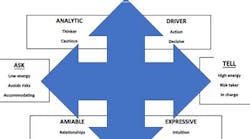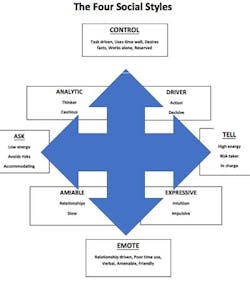Do like Jay Leno: Know the audience you’re playing to (or in this case, treating)
Now that I’ve gotten your attention with that headline, I’ll admit that the closest I've ever gotten to meeting Jay Leno was watching “The Tonight Show.” But I’m sure he would agree that understanding your audience and knowing how to reach them is vital. This is something I see on a daily basis with my students. It’s also something that I deal with regularly, and I’m sure many of you do as well. How do we get our patients to accept the treatment that they need and we recommend?
We need to communicate in a mutually understandable manner. To be able to do this effectively we must not only know the type of person we’re speaking to, but we must know ourselves. Knowing the different social styles will go a long way in making this possible.
So, are you a Driver, an Analytic, an Expressive, or an Amiable? Knowing what you are will make it easier to understand and communicate with others. Different styles prefer to receive information in different ways. Drivers want information directly, quickly, and to the point. Analytics want detailed information. Expressives want information delivered enthusiastically, with emphasis on interesting. Amiables want information presented in a relaxed, stress-free manner.
A brief summary of the four social styles
Drivers react quickly and decisively with definite goals in mind. They like to be in control. Inaction and indecisiveness are pet peeves. Caution and togetherness are of little concern. They prefer to work fast and alone, relying on their individual effort. Drivers have good administrative skills, are efficient, are risk takers, and will do so using their intuition derived from prior experience.
Analytics are slow to react and prefer a cautious and thoughtful approach based on facts. They are good organizers, but prefer to work alone. They have a low risk tolerance, take pride in being precise, and make every effort to always be right. Their actions are deliberate and disciplined, and they have good problem solving skills. Involvement and relationships are not of primary importance for them.
Expressives also react quickly, but their involvement is more group oriented. They prefer to interact with others. They like excitement and shun the boring and routine. They are the life of the party. Getting the job done may take a back seat to entertainment. Therefore, they may react impulsively. They take risks based more on hunches than on the intuitive knowledge used by a driver. Because of their propensity for involvement with others, expressives usually possess exceptional powers of persuasion.
Amiables react slowly. They are relationship driven and avoid conflict at all costs. Opinions matter a great deal to them, so do not expect them to take the lead. They work well as part of a group, but their desire to maintain peace and harmony prevents them from affecting change in a timely manner. Amiables have good counseling skills, which melds readily with their desire to relate to others and to have others reciprocate.
This diagram highlights the various traits and responsiveness of the four social styles.
For example, a “driver” doctor using hard facts and a rapid delivery with an “amiable” patient has about as much of a chance of having the treatment plan accepted as someone throwing a stick toward a cat and telling it to fetch. However, if that same doctor flexes his style to that of the patient’s letting the patient know that others have been in the same situation and been helped by the treatment, it may be more readily accepted. Another way to augment your style is to ally yourself with someone of a different style. A doctor who is very analytic may want an assistant who is more amiable to ensure that the patient feels secure and cared for.
When speaking with patients we frequently don’t take the time to really listen to what they are telling us. We’re in such a rush to provide an answer we often miss what’s being said. Then when we see that deer in the headlights look, we compound the problem by heaping more technical information on the patient. What we really need to do is stop talking. If a patient doesn’t seem to follow, this is the time to ask questions. Once you feel you’ve gotten to what the patient is actually saying, remember their style, and then formulate your reply.
When dealing with the four social styles, it’s a good idea to remember the four Ps – be Pragmatic with Drivers, be Precise with Analytics, be Playful with Expressives, and be Personal with Amiables.
An understanding of the different styles is also of tremendous help when building your team. Keep in mind that analytics and drivers tend to focus on tasks, while amiables and expressives focus on relationships. On the other hand, analytics and amiables tend to react slowly, while drivers and expressives react quickly. So when pairing team members you may want to avoid analytic/expressive combinations, and driver/amiables combinations.
Knowing the various styles will enable you to maximize their strengths and give you insight into how to diffuse tensions. Once the team becomes familiar with the traits of the different social styles, they can use it to recognize these same patterns of behavior in their patients. In this way they can identify which team members can best assist particular patients.
In short, understanding social styles can mean bettering communication not only in the office, but in life. The rewards you gain from better understanding the various social styles are limited only by the effort you put into it.
Gary J. Lucci, DMD, has been a restorative dentist for 32 years. He has been a clinical instructor at the University of Pennsylvania School of Dentistry, and is presently clinical associate professor at the University of North Carolina School of Dentistry at Chapel Hill. Information in this article has been compiled from Dr. Lucci’s studies at the Pankey Institute, his interpretation of works by Merrill & Reid and M. Wm. Lockard, DDS, and his own lifelong observations.





